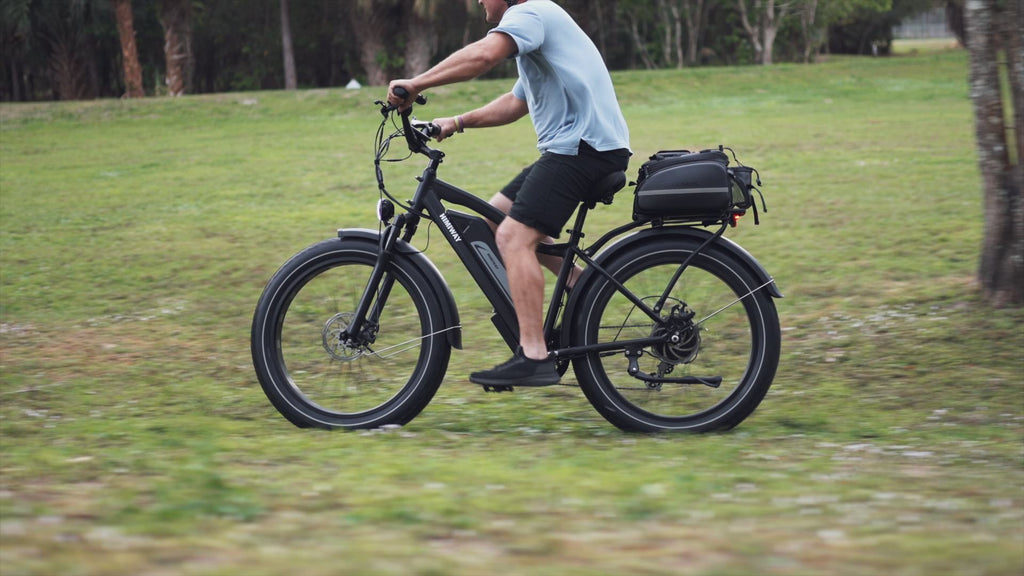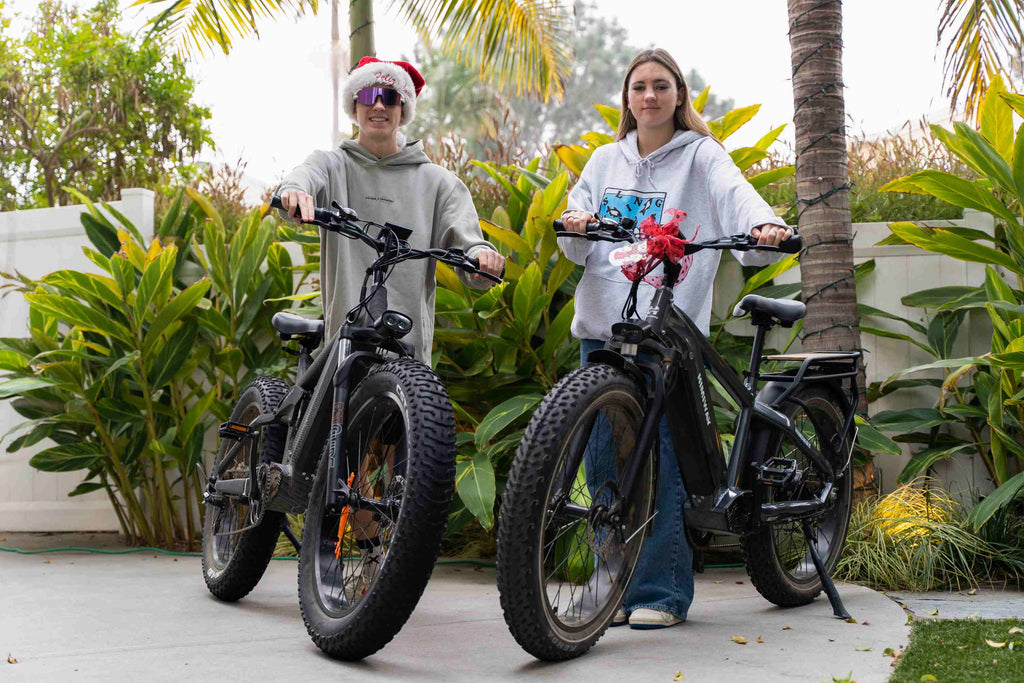
Electric Bike Motor: Which kind of is the Best?
Electric bikes, or e-bikes, are a great way to get around. They're like regular bikes, but with a little extra help from electricity. When it's time to pick your bike, one essential decision is which motor you should go with - rear, mid-drive, or front motors are all available. These different types of engines each have their advantages and disadvantages. Knowing about these can help you choose the right engine for your needs.
Rear Hub Motors
Rear hub motors are mounted in the hub of the rear wheel. These motors provide a direct drive to the wheel, resulting in a more robust and efficient ride.
An example of an e-bike with rear hub motor is the Himiway Cruiser. The Himiway Cruiser electric bike is designed with the modern adventurer in mind, featuring a powerful 750W motor and Shimano 7-speed gear shift system.
Its 26-inch fat tires provide superior traction and stability, while its 840Wh Samsung battery capacity provides up to 60 miles of a single range. Easy-to-use controls make it perfect for those looking to explore outdoors with reliable gradeability.
Benefits of Rear Hub Motors
Rear hub motors provide a more powerful boost, making them ideal for tackling hilly terrain or achieving higher speeds. The direct drive system allows for more efficient power delivery, improving the bike's performance on hills and at higher speeds.
Rear hub motors offer a more natural and intuitive ride, as the power is delivered directly to the wheel rather than pulling the rider along. This can make the bike feel more like a traditional bike and may be more comfortable for some riders.
Rear hub motors can be used with a standard front-wheel gear setup because the engine is not a part of the drivetrain or front wheel. This allows the rider to use the bike's gears to optimize power delivery and efficiency.
If the battery is mounted on the bike frame near the motor, it can help balance the weight distribution. This can improve the handling and stability of the bike.

Drawbacks of Rear Hub Motors
Rear hub motors can make the bike feel less balanced and more challenging, especially at high speeds. The additional weight of the motor and battery at the bike's rear can affect the handling and may require the rider to adjust their riding style.
Rear hub motors, although more expensive than front hub motor models, come with a host of additional components and the need for regular upkeep, which means this type can require higher maintenance expenses. The direct drive system in rear wheel designs makes them far more intricate.
Rear hub motors may not be as suitable for sand or snow, as the rear wheel has a different level of traction than the front wheel. A front or mid-drive motor may be better if you plan to ride in these conditions.
Rear hub motors offer a more dependable and cost-efficient ride than front hub motors. They provide an organic driving experience and compatibility with most standard gear setups on the market. Though they may be pricier and entail additional maintenance needs, their value makes them worth considering – even if you're navigating through sand or snow.
Mid-Drive Motors
Mid-drive motors are mounted on the bike's bottom bracket near the pedals. This motor allows for better balance and handling, as the engine's weight is more evenly distributed.
An example of an e-bike with a mid-drive motor is Himiway Cobra. This motorized powerhouse has a maximum speed of 25 mph and an impressive 400lb payload capacity. Its 26" x 4.8" CST super fat tires provide stability on varied terrains, while the Shimano 7-speed gear shifter system ensures smooth and effortless pedaling with its 750W mid-drive motor at your command.
Himiway Cobra is equipped with a Samsung/LG Quartenary Battery. You can ride up to 60 miles on a pure charge or 80 miles when using pedal assist.
Benefits of Mid-Drive Motors
Mid-drive motors provide better balance and handling, as the weight is more evenly distributed. This can improve the stability and control of the bike, especially at higher speeds or on rough terrain.
Mid-drive motors deliver a more natural and intuitive ride by using the bike's chain drive to transfer power directly to its wheels. This advantage enables them to capitalize on your bike's gears, helping you climb faster and improve efficiency.
Mid-drive motors provide a much more comfortable and relaxed riding posture, as the engine is located close to the pedals rather than in the wheel's hub. This can decrease your back and shoulders stress for a smoother cycling experience.
Mid-drive motors can be more efficient because they can use the bike's gears to optimize power delivery. This can result in a more extended range and better performance on hills.
Drawbacks of Mid-Drive Motors
Mid-drive motors can be more expensive and require more maintenance than hub motors. The added complexity of the mid-drive system can make them more costly to repair or maintain.
Mid-drive motors may be more challenging to install and require additional components such as a chainring or chain tensioner. This can add to the cost and complexity of the motor system.
Mid-drive motors can strain the bike's chain and drivetrain, which may require more frequent maintenance. This can be especially true if the bike is ridden in dirty or wet conditions.
Mid-drive motors may not be suitable for sand or snow, as the drivetrain may not provide enough traction. A front or rear hub motor may be better if you plan to ride in these conditions.
Mid-drive motors can provide improved balance, handling, and power transfer, making them ideal for a more natural and intuitive ride. They are also more efficient than hub motors, allowing electric bikes equipped with mid-drive engines to go farther on a single charge. However, they can be more expensive than other motor options and may require more maintenance.
Front Hub Motors
The front hub motor is placed into the centre of your front wheel and adds a forceful all-wheel drive system to your electric bike. The entrance tire is powered by this engine, while you propel the rear one with pedals for more efficient mobility.
Benefits of Front Hub Motors
Front hub motors are ideal for snow and sand because of the all-wheel drive system they provide. It takes a bit of practice to control this feature masterfully, yet it is well worth the effort with its added capability in such terrains!
Front hub motors are ideal for those looking to build their electric bike or convert a traditional one. This is because these engines don't affect the rear wheel's drivetrain, making them independent from the rest of your setup. As such, you can easily retrofit an existing bicycle and make it into an ebike without any hassles.
The installation and removal of front hub motors are hassle-free because they don't require a gear system, making it effortless to replace flat tires or add/remove the electric bike feature.
Mounting the battery in the middle or back of your bike will balance its weight distribution and dramatically improve its handling and stability, making it easier to ride.
Drawbacks of Front Hub Motors
There can be the feeling you're getting pulled along, and some people don't like this. Pulling along can take some getting used to and may only be for some.
The lighter weight of front hub motors can result in more difficulty maintaining traction or balance on loose or steep terrain. This is especially true for bikes with more powerful hubs, and riders may eventually need to adjust their riding style accordingly.
Front hub motors are typically only available in lower power options because there is less structural support for large amounts of power around the front fork of an ebike. This can limit their performance on steep hills or for achieving higher speeds.
If you often exhaust yourself while climbing particularly long and steep hills, there may be better options than a front hub motor system. Instead, it is recommended to consider investing in either a rear or mid-drive motor if having adequate power for significant inclines is of high importance to you.
The sensors that control the pedal assist level in front hub motors tend to be of a set level style rather than the more reactive sensors used with other ebike motors. This can make the pedal assist feel less intuitive and responsive.
Front hub motors are excellent for creating a DIY ebike or enhancing their traditional bike with electric power. The installation and removal process is simple, and the traction in sand and snow they provide is second-to-none. While other motor types may offer more efficiency and power, front hub motors still deliver decent performance – albeit with some riders experiencing a pulling sensation when using them. Ultimately, however -front hub motors remain suitable options for anyone wanting to build an ebike from scratch or add an electrical element to their existing bicycle.

Which Electric Bike Is Best For Me
The answer ultimately depends on your specific needs and preferences. A front hub motor may be a good option if you plan on riding in snow or sand due to the additional traction the all-wheel drive system provides.
If you need a powerful and efficient motor for tackling hills or achieving higher speeds, a bike with a rear hub motor may be the best choice. As mentioned before, Himiway Cruiser is a great option.
If you want a more balanced and intuitive ride, a mid-drive motor like Himiway Cobra may be the way to go.
When choosing the best electric bike motor for you, consider factors such as the terrain you'll be riding on, your budget, and your desired level of power and efficiency. It is also helpful to test-ride different electric bikes with varying types of motors to get a feel for which one works best for you. And don't forget to consider the maintenance needs of every kind of motor – while some may require more frequent maintenance. They may also offer longer-term cost savings due to their increased efficiency.
A Few Other Things To Consider
One thing to remember when shopping for an electric bike is the motor's power. Motor power is typically measured in watts and can range from 250-750 watts for most electric bikes. A higher-wattage motor will generally be more powerful and efficient, but it may also be more expensive and require more maintenance.
Alongside the type and power of the motor, it's worth considering the battery when shopping for an electric bike. The battery powers the engine and will determine the range of the bike. Batteries are typically measured in watt-hours (Wh) and range from 300-1000 Wh for most electric bikes. A higher watt-hour battery will generally provide a more extended range, but it may also be heavier and more expensive.
When considering the battery, it's also essential to consider its type. Most electric bikes use either a lead-acid battery or a lithium-ion battery. Lead-acid batteries are generally cheaper and have a shorter lifespan, while lithium-ion batteries are more expensive but have a longer lifespan and are usually lighter in weight.
Finally, reviewing the electric bike's overall build and components is important when deciding. Quality components such as a strong frame, reliable brakes, and smooth shifting gears can make a big difference in the overall performance and enjoyment of the bike.
Summary
Choosing the best ebike and motor for your needs will depend on various factors, including the type of terrain you'll be riding on, your budget, and your desired level of power and efficiency. Considering these factors and test-riding different electric bikes can help you find the perfect motor for your needs. Whether you choose a front hub, rear hub, or mid-drive motor, follow safety guidelines and laws to ensure a safe and enjoyable riding experience.







































 NL
NL
 United States
United States Canada
Canada Deutschland
Deutschland United Kingdom
United Kingdom Switzerland
Switzerland
